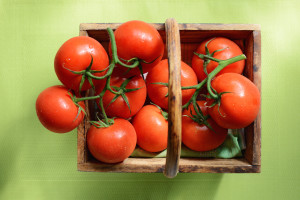Summer in the South means fresh, delicious seasonal produce—making it easy for even casual cooks to create healthy dishes that are full of flavor. With so many fantastic fruits and vegetables in season during the months of July and August, your recipe options are almost endless.
Whether you visit one of the local NC Farmers Markets, shop in a grocery store or even benefit from the bounty of a garden-growing neighbor, relative or friend, take advantage of this spectacular growing season and stock up on the season’s finest fresh produce. Then start cooking! Your taste buds, your family and your health will thank you!
What’s in season?
-
Zucchini and summer squash
Look for: Zucchini and summer squash should be firm and heavy for their size. Their skins should be bright yellow or green, and free from dents. Try to choose squash and zucchini that are less than eight inches long. Smaller squash and zucchinis are more tender than larger ones, because they are harvested earlier. If you find yourself in possession of an enormous squash or zucchini, try either stuffing it, or grating it into a zucchini bread or squash casserole.
Storage: Zucchini and squash can be stored in the refrigerator in a perforated plastic bag for up to a week.
-
Tomatoes
Fresh tomatoes are the stars of summer meals. While you can find tomatoes in the grocery store year-round, they’re never as flavorful as they are in summer. The best-tasting tomatoes are grown locally, and not yet refrigerated.
Look for: Find fragrant tomatoes that yield slightly to the pressure of your finger and that are heavy for their size. The skin should be smooth and brightly colored, no matter if they’re red, orange, yellow, or (if you’re buying delicious heirloom varieties) striped, green or purple!
Storage: Refrigerating tomatoes affects their flavor, so keep them on the countertop. Buy small quantities at a time if you think they’ll go bad before you use them.
-
Corn
North Carolina produces delicious corn in all varieties: yellow, white, and bicolor. Its taste peaks in late summer.
Look for: Ears should be fully encased in bright-green husks and topped with golden tassels. Check out what’s inside: even in a grocery store, you should be able to pull back just enough of the husks to make sure the kernels are healthy and in tight rows.
Storage: Corn begins to lose its natural sweetness as soon as it is picked, so try to eat it the day you buy it. If you can’t, you can easily refrigerate ears in their husks for up to two days.
-
Eggplant
You may be most familiar with globe (or Italian) eggplants, with their large bodies and dark-purple skins, but the smaller, narrow Japanese eggplant has fewer seeds, a thinner skin and a milder flavor that cooks beautifully. At the farmers market, all types can be found in shades ranging from white to lavender to striped to dark purple—or aubergine, as the French call their eggplant.
Look for: Healthy eggplants are shiny and firm with green stems and no brown or soft spots.
Storage: Refrigerating eggplant will damage its texture, but most eggplants will stay healthy on a cool countertop for a few days.
-
Peppers
Although all peppers start out green, their colors change to red, yellow, orange and purple, and their sweetness grows in proportion to how long they’re allowed to ripen on the vine.
Look for: The juiciest peppers are firm and heavy for their size, with taut skins and thick walls. Avoid any peppers that are wrinkled or cracked.
Storage: Refrigerate in a paper bag in the crisper up to five days.
-
Cantaloupe
Look for: The lighter the color the better for this king of fruits—a nice beige is good. Check for softness on the blossom end—it should have some give, but not too much. And sniff: the melon should be fragrant, but not overwhelming.
How to store: Store whole melons in a cool spot on the counter. Cover wedges in plastic and refrigerate up to 4 days.
-
Blackberries
They have a short growing season, and are all the more precious (and valued) for it. Eat them while you can!
Look for: Choose ripe, bright and aromatic berries, avoiding any cartons with bruised or moldy fruit.
Storage: Refrigerate unwashed berries in their containers and use within a few days. As they’re sensitive to moisture, avoid storing them in plastic bags. Wash just before use.
-
Blueberries
North Carolina is having a record blueberry season, and you’ll find an abundant supply at every market you visit. They’re one of nature’s most perfect foods—high in vitamins and antioxidants, and no peeling required!
Look for: Look for firm, deep blue berries with a uniform size and a silvery sheen.
Storage: Remove any soft berries, twigs or leaves, and refrigerate the berries in their cardboard container for up to five days. Only when you’re ready to use them should you wash them. Rinse under cold water, drain and pat dry with a paper towel.
-
Plums and Peaches
Carolina plums are crimson to black-red with a yellow or reddish flesh; the storied Carolina peaches are famous for their golden yellow flesh. Both taste as sweet as can be imagined.
Look for: Plums should be evenly colored and plump; peaches should show a blush of color. Fruit should yield gently to pressure, but stay away from any with extremely soft spots unless you’re using them to make jam. If you find them all to be firm, simply place them in a closed paper bag at room temperature for one to two days.
Storage: Once ripe, plums and peaches can be kept in a plastic bag in the refrigerator up to three days.
What’s cooking?
If all this talk about fresh seasonal produce is making you hungry, here are two delectably simple, crowd-pleasing recipes to get you started. Summer vegetables feature prominently in both, and neither is very complicated to prepare.
Tomato and Fresh Corn Salad with Shallot Vinaigrette
Makes 4 servings (and extra vinaigrette)
For the vinaigrette:
- ½ cup extra-virgin olive oil
- ¼ cup Sherry vinegar
- 1 tsp. Dijon mustard
- 1 small shallot, minced
- A generous pinch of sea salt
- Freshly crushed black pepper
For the salad:
- Enough tomatoes for 4 people, whatever sizes you have! For example:
- 4 regular-sized tomatoes, sliced + 2 handfuls cherry tomatoes, halved
- 2 beefsteak tomatoes, sliced + 2 handfuls cherry tomatoes, halved
- 6 regular-sized tomatoes, sliced
- 6 handfuls cherry tomatoes, different sizes, halved or quartered, depending on the size
- 1 ear of corn, kernels cut off from the cob and lightly steamed (see the microwave shucking method)
- 5-6 fresh basil leaves, thinly sliced
- Crunchy sea salt, such as Fleur de sel or Maldon Sea Salt Flakes (optional)
To make the vinaigrette:
Put all the ingredients in a screw top glass jar. Tightly close the jar and shake vigorously. Put aside until ready to dress the salad, or store in the fridge if you’re making it ahead of time.
To make the salad:
Place the sliced tomatoes on a large serving platter (or divide between individual plates). Scatter corn kernels over the tomatoes. Season with crunchy sea salt, then drizzle generously with vinaigrette. Sprinkle with the fresh basil. Serve immediately with crusty bread to mop up the juices.
Recipe credit: Adapted from Molly Wizenberg.
Ratatouille
Makes 6 servings
- 1⁄2 cup extra-virgin olive oil
- 1 tbsp. dried herbs de Provence (available at most grocery stores or Whole Foods)
- 6 cloves garlic, smashed and peeled
- 2 large yellow onions, quartered
- 1 bay leaf
- 2 medium zucchini (about 1 1⁄4) cut into 2″ pieces
- 1 medium eggplant (about 14 oz.) cut into 2″ pieces
- 1 red bell pepper, stemmed, seeded, and quartered
- 1 yellow bell pepper, stemmed, seeded, and quartered
- 10 plum tomatoes, with skins removed (see instructions below)
- Kosher salt and freshly ground black pepper, to taste
- 1 tbsp. chopped fresh basil leaves
- 1 tbsp. chopped fresh flat-leaf parsley
To remove skins from tomatoes: Place a large pot of water on the stove and bring it to a boil. Then, drop the tomatoes into the boiling water. Using a slotted spoon or tongs, remove tomatoes after 30 seconds or when the skin begins to peel.
To make ratatouille:
Heat oven to 400˚.
Heat oil in a 6-qt. Dutch oven over medium heat. Add herbs de Provence, garlic, onions, and bay leaf; cover and cook, stirring occasionally, until soft and fragrant, about 10 minutes.
Increase heat to high; stir in the zucchini, eggplant, peppers, and tomatoes and season with salt and pepper.
Uncover pot, transfer to the oven, and bake, stirring occasionally, until vegetables are tender and lightly browned, about 1 1⁄2 hours.
Stir in basil and parsley, transfer ratatouille to a serving bowl, and serve warm or at room temperature.
Recipe credit: Adapted from Saveur.


